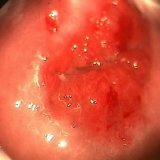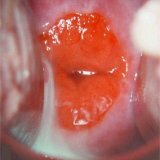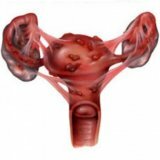Oligomenorrhoea
 Oligomenorrhea is an increase in the interval( not more than 35 and at least 60 to 90 days) between menstruations. Menstruation with oligomenorea can be short and last from a few hours to two days. Oligomenorrhea as a symptom is included in the clinic of hypomenstrual syndrome, infertility and other serious hormone-dependent diseases.
Oligomenorrhea is an increase in the interval( not more than 35 and at least 60 to 90 days) between menstruations. Menstruation with oligomenorea can be short and last from a few hours to two days. Oligomenorrhea as a symptom is included in the clinic of hypomenstrual syndrome, infertility and other serious hormone-dependent diseases.
Short-term oligomenorrhoea often appears during the period of formation( puberty) or the extinction of menstrual function( menopause) on the background of changes in hormonal regulation. Such oligomenorrhoea can be attributed to the physiological, it does not require therapy and passes by itself. To the physiological one can also include oligomenorrhea in a small number of women with a regular( regular) large interval( about 50 days) between menstruations, if they retain the ability to conceive( fertility) and do not have concomitant endocrine diseases.
If the original oligomenorrhea in adolescents does not transform into a normal menstrual cycle, it is called primary. Secondary oligomenorrhea occurs in women with normal menstrual function against the background of pathological hormonal and endocrine changes.
Irregular menstruation is the most frequent reason to call a doctor. The menstrual cycle is a very complex mechanism of interaction of all structures responsible for the hormonal, endocrine and central nervous activity of the body. During the life of the majority( 70%) of women there are violations of the menstrual cycle of a different nature. As a rule, such violations are temporary. If they are accompanied by more serious symptoms, for example, infertility, you need to understand the reasons and conduct adequate therapy. It is generally believed that if the number of menstruation continues to decline annually( less than 7 per year), even in the absence of other anxiety symptoms, a doctor's consultation is necessary.
The normal menstrual cycle provides cyclic changes in the quantitative composition of pituitary and ovarian hormones under the control of the central nervous system( hypothalamus).In healthy women, the menstrual cycle is biphasic. In the first phase, under the influence of follicle-stimulating hormone( FSH) in the ovaries begins to mature follicle - "bubble", in which the female reproductive cell( egg) grows and develops. In turn, the ripening follicle helps increase the amount of estrogen( primarily estradiol) and the growth of the inner layer of the uterus( endometrium).By the middle of the cycle, the level of FSH is reduced to a minimum and the main role is played by luteinizing hormone( LH) and progesterone. The drop in the level of estrogen and the increase in the content of progeston lead to the fact that a mature egg leaves the follicle within an hour, that is, ovulation occurs. If the egg is not impregnated for two days, it dies, and in the uterus the process of rejection of the enlarged endometrium begins, which ends with the menstruation. The degree of expression of hormonal dysfunction in women with oligomenorrhea can range from insignificant to severe, leading to anovulation and infertility. Oligomenorrhoea often precedes amenorrhea - complete absence of menstruation.
The causes of oligomenorrhea
Primary oligomenorrhea in adolescents is associated with impaired proper puberty and / or congenital malformations( abnormalities of development) of genital organs. Prerequisites for the development of primary oligomenorrhea are formed during fetal development.
Secondary oligomenorrhea may occur in women with a normal menstrual cycle after severe psychological trauma or severe physical exertion. Inadequate nutrition and occupational hazards can also negatively affect menstrual function.
Among the causes of oligomenorrhoea, there are:
- Acute or chronic infections( endometritis, adnexitis, salpingoophoritis, and so on);
- Dysfunctional functional impairment in the pituitary-hypothalamus system associated with trauma, infectious or mental illness;
- Endocrine non-gynecological pathology of endocrine glands. Changes in the quantitative production of thyroid hormones, adrenal glands or pancreas lead to a general hormonal imbalance and affect the work of the ovaries;
- Incorrect use of hormonal medications, including contraceptives;
- Polycystic ovary syndrome. It is characterized by an abnormal increase in the content of androgens( male sex hormones) that compete and displace estrogens;
- Deficiency of weight. The reason for its reduction can be a natural weight loss due to severe acquired or congenital ailments and / or poor nutrition. Excessive desire of women to reduce weight by artificial means can also lead to the appearance of oligomenorrhoea.
With oligomenorrhea, the menstrual cycle is distorted. The cycle maintains its two-phase state, but the duration and the ratio of the two phases change. The probability of ovulation with such changes becomes small - it occurs only in 20% of patients.
The causes of the physiological oligomenorrhea are not established.
Symptoms of oligomenorrhea
Oligomenorrhoea is not a disease for which a whole complex of symptoms is inherent. It in itself is the only symptom, the essence of which is very short( not more than two days) menstruation. That is why the diagnosis of oligomenorrhoea is never final, it merely points to a dominant symptom that requires clarification of the cause of its appearance. Almost always oligomenorrhea is combined with another symptom - the opsonomena, which denotes rare menstruation, so they are often combined and called "oligomenorrhea".The amount of menstrual blood can vary from mild to moderate. If the amount of blood lost does not exceed 40 ml, it is called hypomenorrhea. The combination of oligo-, opsono- and hypomenorrhea is called hypomenstrual syndrome, which is a serious disease.
Thus, oligomenorrhea is a symptom that can be present in many other diseases, for example, fever or headache accompany a huge number of ailments. Complaints of patients with oligomenorrhea are determined by the underlying disease that caused it.
Most often, oligomenorrhea as a symptom accompanies:
- Fat metabolism disorders, whose external signs are excessive body weight and acne, fat deposits can be non-physiological;
- Hirsutism, or hair growth "according to the male type": under the influence of androgens( male sex hormones), dark hair appears in the chest, upper lip and chin, on the back and on the abdomen;
- Male constitution;
- Infertility;
- Decreased sexual desire;
- Exhaustion of the patient. Abuse of diets and starvation to reduce weight can lead to disruption of menstrual function.
The essence of the diagnosis of oligomenorrhea is to determine its causes. Gynecologic examination allows to determine the condition of the uterus and appendages, to reveal the presence of inflammatory diseases. Taking smears allows you to detect or rule out the presence of infection.
It is impossible to overestimate the importance of hormonal research. Determination of the level of sex hormones - FSH, LH, prolactin, estradiol and progesterone - is necessary for determining the nature and extent of hormonal disorders, and also for choosing a method of therapy. For the diagnosis of infertility it is important to establish the absence of ovulation. Hormonal research is conducted in accordance with the phases of the menstrual cycle.
Ultrasonic scanning( ultrasound) of pelvic organs determines the size of the uterus and appendages, reveals abnormalities in their development and diagnoses inflammatory processes. Particularly closely examined are the ovaries, namely, the size, circulation, tissue density, the presence of follicles, signs of polycystosis, and so on.
Hysteroscopy is infrequent as often as necessary.
Survey and consultation of related specialists help to establish the non-gynecological nature of oligomenorrhoea. The endocrinologist, neuropathologist and therapist, if necessary, conduct a survey within their specialty.
After a complete examination, the diagnosis of oligomenorrhoea is not correct and gives way to the diagnosis of the underlying disease that led to the oligomenorrhea.
Primary oligomenorrhea
The diagnosis of primary oligomenorrhea is given to patients at a young age, if the end of puberty is not accompanied by the establishment of a normal rhythm of menstruation( a period of 21-35 days and duration of 8, but not less than 2 days).
Primary oligomenorrhea is most often the result of intrauterine growth retardation, accompanies hypoplasia and / or infantilism of the genitals. If the size of the uterus does not correlate with the age norm, they speak of sexual infantilism. The degree of severity of sexual infantilism is determined by the presence or absence of ovarian insufficiency and the level of underdevelopment of the uterus:
- The first degree of infantilism is very rare and relates to developmental anomalies, characterized by the presence of a rudimentary uterus. Menses are practically absent. The restoration of the normal structure of female genital organs with such a structure is impossible.
- The second degree of underdevelopment corresponds to the "infantile" size of the uterus and is accompanied by oligomenorrhea. Adequate long-term treatment contributes to the restoration of the normal anatomical structure of the organ.
- The third degree of infantilism is the uterine hypoplasia. Uterus has a normal structure, but its size does not correlate with the age norm. The causes of hypoplasia can be severe infections or inflammatory diseases of the genital organs during puberty. Oligomenorea with hypoplasia is temporary and lasts until the uterus "grows up" under the influence of therapy. Hypoplasia of the uterus can disappear on its own due to internal hormonal resources.
Ultrasound examination in the presence of primary oligomenorrhea allows to determine the presence of abnormalities in the development of genital organs, and laboratory tests will establish the nature of hormonal disorders.
Secondary oligomenorrhoea
Secondary oligomenorrhoea never accompanies puberty, it is inherent in older women. This is facilitated by a variety of reasons - from the most "simple" like overwork or colds to serious illnesses. The appearance of a short-term disturbance of the menstrual cycle with subsequent independent recovery is an absolutely normal situation.
If oligomenorrhoea exists for a long time, accompanied by such troubling symptoms as infertility, hirsutism, obesity, decreased libido or endocrine disorders, an in-depth examination is required.
Treatment of secondary oligomenorrhea implies the elimination of the underlying disease.
Treatment of oligomenorrhea
For successful elimination of oligomenorrhea, it is necessary to establish its cause. Treatment of oligomenorrhoea is not carried out:
- When young girls without a sign of abnormality of development of genital organs and endocrine pathology are patients, observation is allowed for two years;
- In the period of extinction of menstrual function( menopause);
- If oligomenorrhoea is caused by short-term causes. For example, if the causes of oligomenorrhoea are excessive physical exertion or fatigue, the oligomenorrhoea will self-destruct.
The presence of endocrine pathology requires treatment with an endocrinologist. The menstrual cycle can be normalized only after adequate therapy of the underlying disease.
After the treatment of the underlying disease is successfully completed, the menstrual cycle is restored by hormonal correction. A situation is possible when the menstrual cycle is restored without medication.



